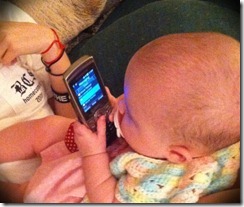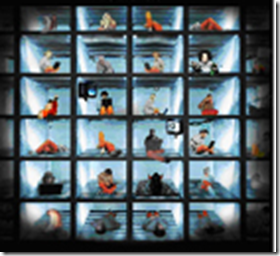I Just Returned from the Future
/ I just returned from the future.
I just returned from the future.
In one of the strangest experiences I have had in a while, I lived the future as I read about it! I did not realize it for a while but then it struck me suddenly over dinner—”I am what I’m reading!”
Let me explain.
As I write this I am nearing the end of my annual Think Week (you can read details about Think Week in these two articles: How to Reduce Stress While Getting More Done; and in How To Find Time to Focus, Think, and Work). During my Think Week my primary focus is prayer and reading. On this trip I took several books with me including Humility (Andrew Murray), The Culture Code (Clotaire Rapaille), Think: The Life of the Mind and the Love of God (John Piper), Derailed (Tim Irwin), Death by Meeting (Patrick Lencioni), and Generous Justice (Tim Keller).
I also took Anywhere: How Global Connectivity is Revolutionizing the Way We Do Business (Emily Nagle Green). This is the book I was reading when I realized that I was living the future. I will summarize some of the key points of this book and their implications for our schools in a subsequent post but for now let me simply state the theme of the book;
Within the next ten years the global ubiquitous digital network will connect most of the world’s people, places, information, and things, which will fundamentally alter the way we live, work, teach, and learn.
The author, Emily Green, knows what she is talking about. She is the President and CEO of the Yankee Group—one of the world’s premier research firms on the impact of the global connectivity revolution with operations in North America, Europe, the Middle East, Africa, Latin America and Asia-Pacific.
One of the most fascinating parts of the book is her description of five consumer segments: Analogs, Technophytes, Digital Shut-ins, Outlet Jockeys, and Actualized Anywheres (AA’s). As I was enjoying my dinner and reading it suddenly dawned on me just how much I was exhibiting the characteristics of the Actualized Anywheres. The short description of AA’s is that they “bring the concept of a ubiquitously connected consumer to life.” This is when it struck me—-I was literally living the future she was describing!
Here is how I know. I wrote down how I was handling my recreational and work related tasks during Think Week. Here is a short list.
- All of my books, newspapers, and magazines are on my iPad. I read, highlight, annotate, and share my reading content electronically.
- I downloaded a book immediately onto my iPad based on a recommendation from the book I was reading at the time.
- I held a video-call with my daughter and grand daughter using FaceTime on my iPhone.
- I sent an email through Facebook to some friends and family. I accepted a connection request with a professional colleague on LinkedIn.
- I used the Yelp application on my iPhone to find restaurants and read reviews before choosing a place to have dinner. I also wrote my own review on Yelp for the benefit of others.
- I used my Garmin GPS to guide me to the restaurant.
- While driving and while dinning, I used an iPhone application called SoundHound to identify and order songs to download. I liked the songs but could not remember the titles. SoundHound solved that problem.
- I used an application called NoteSelf on my iPad to take notes using a stylus, including notes for this blog article. No paper or pen needed.
- I used the Evernote application to send clippings from the books I was reading to my administrative assistant for her to type so that the information could be put into my Endnote program for future reference and citation.
- I used Logos Bible Software on my computer to study and write a devotional for my faculty.
- I used Adobe Acrobat to print the devotional as a PDF. I uploaded it to Box.net (cloud storage and collaboration) so it could be shared with our parents with a hyperlink in an email, and then I emailed it to all school staff using Outlook.
- I used LoseIt on my iPhone to track my calories and my running.
- One of the books I was reading referenced a 2004 NYT article on how Apple Outflanked Sony in music players (this had to do with Disruptive Innovation). I went to the NYT website and downloaded the article.
- I am using my laptop to type this article using Live Writer, which I will then post to my blog using the same program.
Now, before you react with something like “are you crazy?!” let me highlight the key point. I am using mobile devices connected to a global digital network everywhere I go to get things done and to enhance and enrich my life. I have a seminary’s worth of books in my Logos Bible program. I have an entire library on my iPad for reading. I have a huge music library of beautiful music in my pocket. I can find and read reviews on local restaurants before deciding where to eat. And I was able to speak with AND see my granddaughter even though I am hours away in a hotel.
Some of my readers, perhaps many of them, have no intention or interest in using technology in the ways I describe above. That is okay. They are most likely Analogs. Most people are. All of us fall into one of the consumer segments that Emily Green describes in her book.
What does this have to do with our schools? Plenty! What I just described is how most of our younger parents and our students will conduct their personal and professional lives.
As school leaders we must understand that our younger parents (those born in the mid to late seventies) and certainly our current students and our future parents DO CARE. They will live and work much as I have described above. Mobile computing and connectivity will be a given—it will be woven into their lives. Their expectations are, and will increasingly be, that our classrooms and school-to-home communication reflect the realities of the new Anywhere Global Connectively.
This is a sea change. It is as evitable as the sun rising tomorrow.
Are we preparing our school infrastructures for this change? Are we preparing and training our faculty? Are we preparing our students for the new work world of tomorrow? Are we providing a biblical framework for understanding and using technology for God’s glory? Are we modeling the use of technology for our teachers and other administrators?
This is one of my favorite quotes from the book:
New things are an easy target for those who lack imagination … Years ago, no one understood why e-mail was worthwhile. Now, no one thinks twice about it—but they’re busy talking about why Twitter is stupid. Bob Metcalfe
Let’s put our sanctified imaginations to work—let’s travel to the future and then return to our schools to get ready!



 Dr. Barrett Mosbacker, PublisherFacebook recently irked me. I am a Facebook user but I am not a heavy user. I keep up with a few colleagues and friends but mostly I post articles on Facebook that I believe others may find interesting. I mostly use Facebook so that I can work through the biblical, educational, and social implications of social technologies as a Christian. We are called to bring all of life under the Lordship of Christ—that includes Facebook and similar technologies.
Dr. Barrett Mosbacker, PublisherFacebook recently irked me. I am a Facebook user but I am not a heavy user. I keep up with a few colleagues and friends but mostly I post articles on Facebook that I believe others may find interesting. I mostly use Facebook so that I can work through the biblical, educational, and social implications of social technologies as a Christian. We are called to bring all of life under the Lordship of Christ—that includes Facebook and similar technologies.  moments to the Web for all to see. It’s easy to say that privacy is dead, we all live in public now, and just deal with it.
moments to the Web for all to see. It’s easy to say that privacy is dead, we all live in public now, and just deal with it.![[EMAIL]](http://s.wsj.net/public/resources/images/TE-AA822A_EMAIL_F_20091008202711.jpg)
 Duct Tape Marketing
Duct Tape Marketing